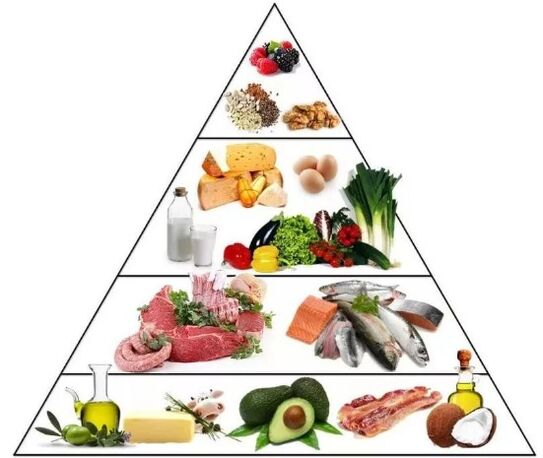Strictly speaking, only one that causes an elevated blood level can be called a ketogenic diet.
However, since this level is rarely controlled by study participants and is merely a believer in this nutrition, in this article, keto diet will be referred to as all power options, with a carbohydrate amount less than 10% of the daily calorie content. Here we also assign a low-carb diet, often distinguishing it into separate nutritional types.

Most of the sources of calorie boundaries for both diets are as follows:
- Ketones account for 5% of carbohydrates per day
- Low Carb Diet - 5-10%.
physiological
Without it, there is no way here. Therefore, because carbohydrates are different in diets, covering up to 60% of their daily energy needs, the body receives almost all the energy from glucose, which is the ultimate product of carbohydrate division.
The energy system of all organ cells is suitable for glucose fuel. Available from it easily and quickly. Glucose passes through all natural barriers in the human body (for example, there are natural barriers in the brain), from which some organs can only get energy—for example, the liver and blood red blood cells.
But if the glucose levels in the blood drop – for example, you haven’t eaten for a long time? Or is the owner of this blood entering the keto diet? Then the same fat enters the stage. It breaks down into ketone bodies (from the name of the diet and the name of the diet) - fragments of fat molecules, which include beta-oxygenic acid, acetic acid and acetone. As you can see, two of the three ketone bodies - acid. Remember the future.
Furthermore, ketone bodies are distributed throughout the body, because of their small size, they penetrate well through obstacles to organ containers and are absorbed by cells (except for liver cells, they don't know how to use), and give more unit mass energy than glucose.
What is capture?
First: Ketone bodies - acids. Increased concentrations in the blood will change its acid-base balance.
Yes, in healthy adults, blood pH does not change as a key indicator. This is a fairly frequent phenomenon in children, such as those with diabetes.
Maybe you have heard of "acetone increase" in young children? To return to normal, do you need a drop of glucose, or if conditions allow you to steal sweet candied on a teaspoon (because any large amount of vomit will vomit) for a few days? thisKetoacidosis- Increased ketone body content to increase blood oxidation, we tried to call artificially with diet.

Second: It is completely different to obtain energy from ketone bodies chemically compared to glucose. For normal nutrition, this pathway is rarely involved and there are few necessary enzymes.
Therefore, the transition between normal and keto diet can be heavy. However, this attracted athletes - Keto-Diet to train the energy path of fat, and subsequently, the body is easier to rebuild.
Ketogenic diet and excess weight
Everything here looks very optimistic. In this study, obese patients decreased by 19. 9 kg, while those with obesity decreased by 19. 9 kg, but only 7 kg of calories were reduced. In addition, after converting ketones to normal power, the weight continues to drop.
In a similar study that lasted for two years, participants dropped 12. 5 kg on ketodita, mainly due to fat, reduced waist volume, and at the same time, people reduced only 4. 4 kg on their normal diet.
On Keto-Dita, plus training, participants lose weight due to fat. At the same time, the control group with regular nutrition and the same training gained weight. The two groups of diets have no limit on calorie content.
A review of publications on the effectiveness of ketogenic diets in obesity confirms its effectiveness and issues some important warnings:
- Ensure the work of controlling the kidneys;
- It's important to be neat, gradually transitioning to keto diet and return to traditional nutrition.
- Duration may range from two weeks to one year or more (usually a strict limit on carbohydrate receipts (less than 5% of a day’s reserves) and for a limited period of time, softer options - several months or more);
- The keto diet is a treatment for obesity, and the attitude towards obesity should be any other medication and is controlled and supervised by a doctor.
Keto diet and exercise results
Based on glucose metabolism and ketone body characteristics, it can be assumed that a traditional diet with a large amount of carbohydrates better provide the body's needs under short, high-intensity loads.
Keto-Diet trains the ability to receive energy from fat, improves tolerance and leads to long amounts of long intensity. Well, at the same time, kilograms are clearly promoted through kilograms. This is confirmed in part by the study.
For example, in a group of athletes engaged in sports walking, after three weeks of keto diet, vo2max increased, but the result worsened because more oxygen was needed to oxidize the ketone bodies. In groups in the diet, having the same training diet, or constantly getting carbohydrates, the results were improved.

As we expected, even a short-term (4-day) keto diet can exacerbate the results in anaerobic high-intensity exercise.
After 12 weeks, athletes participating in endurance athletes had a mass reduction of 5. 9 kg, reduced subcutaneous fat, and increased ketone body levels by 5 times, but the results of training (compared to the control group receiving conventional carbohydrate amounts). Perhaps because in the test, a set of electrolytes and control carbohydrate drinks were performed on dry water in keto red.
The combination of weightlifting and keto diets helps effectively remove fat while maintaining exercise indicators (study) and is logically unsuitable for recruiting muscle mass.
All:
- The Keto diet increases the maximum of VO2, and when long-term low-intensity training prevails, the focus of endurance is very suitable for training seasons.
- Large training volumes are used in combination with keto diets, reducing the amount of fat, weight and muscle damage after loading (because lactic acid does not form from the ketone body).
- On the other hand, the reduction of glycogen reserves and the low activity of enzyme cleavage worsen the results of the velocity work.
Ketogenic diet and various diseases
When Keto-Diet only appeared (in 1920 people were not suffering from obesity, they were happy for him), it was a visibility of an effective means of alleviating epilepsy states. Now, it is also used as an additional treatment for drugs for epilepsy cases, and although it works at the molecular level, it is still difficult to understand.
In patients with the second type of diabetes (not dependent on insulin), the keto diet proves effective (better than the usual low-calorie diet) and is a fairly safe way to lose weight and control blood sugar levels.
The keto diet also helps with polycystic ovarian syndrome, reducing psychological and physiological symptoms.
side effect
The keto diet is not the most physiological diet, it can very much change metabolism, forcing it to work in a "reserve" mode, which uses ordinary nutrition and is extremely rare.

Therefore, different unpleasant feelings are often found, especially when switching to a keto diet and vice versa. The most common are headaches, nausea, vomiting, fecal disease, and back pain.
Mineral and fat metabolism, the formation of kidney stones, and metabolic acidosis (changes in blood pH on the acidic side). Acidosis can achieve a key significance in children and people with impaired sensitivity to insulin, leading to coma.
To prevent these side effects, during keto diets you need to take vitamins, minerals, proteins, drink plenty of water, and have a lot of vegetables. Medications can be included in the diet.
People who are taboo in keto diet
First, people with congenital fat metabolism diseases. If anything, it's very likely that you know this. But checking it will not hurt.
Keto-Diet is also banned from porphyria patients and pyrrolidine carboxylase deficiency (sorry, regrets here, but, again, if a person has any of these diagnoses, he will see him and will not risk health on keto diet).
For patients with the second type of diabetes, type 2 glucose Coter Coter is taken. They should change treatment or avoid ketone ketones.
Total: What, to whom, how to eat and whether you need it
The keto diet is actually more effective than simple calorie restrictions, helping to lose weight in body fat without causing muscle loss. It also helps with some endocrine pathology.
The power of low carbohydrates stimulates the path to get energy from fat, so it is easier for the body to rebuild this metabolism due to long, low-intensity loads. The results do not change, and sometimes worsen. In Sprint, they always deteriorate. The keto diet should be performed in the middle of the training season, and the important start is far away, the quantity is large, and the speed is low.

Before you change the power type, you need to make sure you are consistent with the fat exchange. The entrance and exit of the diet should be gradual and the wells are monitored carefully. In the diet, it is important to drink plenty of water, have vegetables, and take vitamins and trace elements.
It is best to think of Keto-Diet as a diet, but rather as a medical event that requires a constant laboratory and preferably medical control.
As a safer option with tight results, we offer a low-carb diet (about 10% of the daily diet is carbohydrate) and regularly incorporate into diets with useful carbohydrate products such as whole grains. She had fewer side effects and the results were close.
As an experiment, try to remove fast carbohydrates from your diet. They are hurt a lot, no benefit (besides the joy of eating delicious cakes), weight will be reduced, and you will discover what the limits of carbohydrates are - successful experiments in every aspect!
Run often, eat delicious and healthy!






























